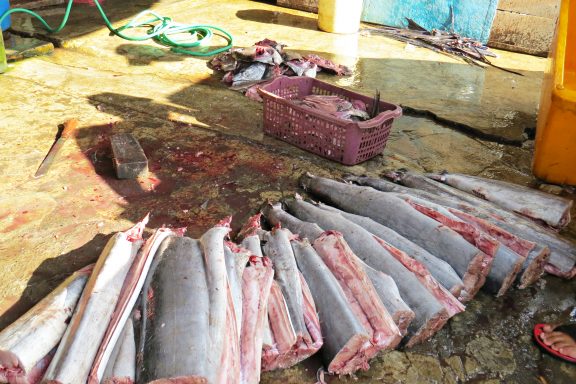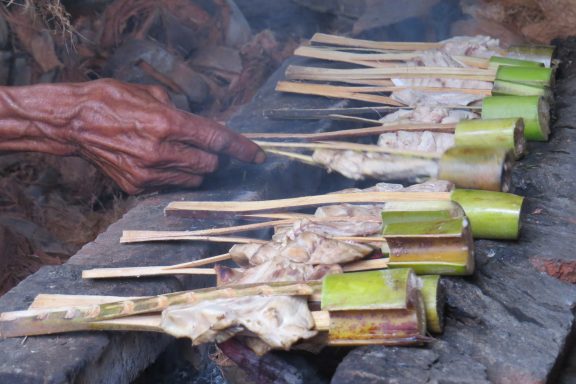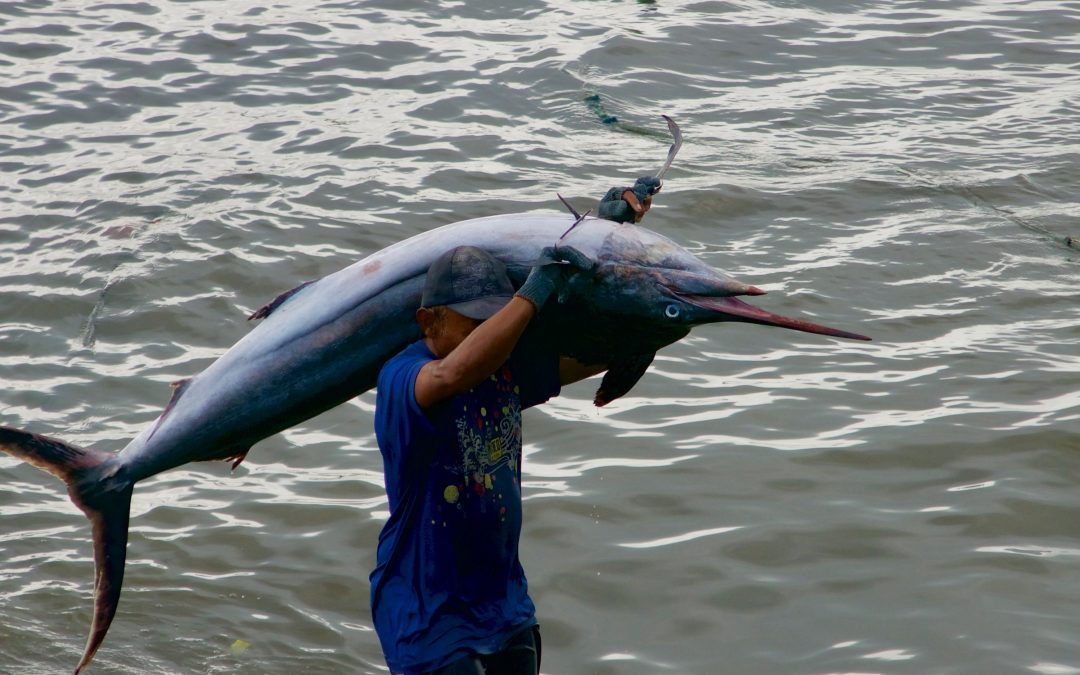Over the past six months our Sustainable Fisheries team have been working with fishermen in Muncar to reduce unwanted bycatch of mobula rays. A large proportion of this bycatch occurs within the drifting gilnet fisheries that target marlin, sailfish and swordfish. In this post I will compare the supply chains for target species and non-target mobula rays, and explore how markets could influence sustainable practices within the fishery.
Muncar is a major fishing port. If you buy marlin in Banyuwangi traditional market, or even from a restaurant throughout East Java or Bali, there is a good chance that your fish was landed in Muncar. While fishermen sell some of their catch to local consumers, often their catches exceed the local demand and so fishermen seek out wider markets. Many different actors play important roles along these supply chains, transform the fish into new products, and transporting and delivering the fish to the consumer. But there are some important and interesting diffrences between the supply chains of target fish and bycatch.
Fishermen sell marlin to middlemen (known as Pengambak) for IDR 25,000 – 34,000 who often freeze and store the catch. Pengambak also act as an aggregator and seek to maintain a stable supply of raw material, including by financing fishing operations or providing loans to cover the cost of fuel or maintaince. The relationship between fishermen and Pengambak is very close.
The first processing occurs when distributors (known as Saudagar) came to purchase fish. The marlin are gilled and gutted by the Pengambak, and body parts sold to the Saudagar. Fins and heads are sold for IDR 3000 per kg for processing into animal feeds. Edible organs, like the heart, are usually taken home by the fishermen. The body is sold to the Saudagar, who may collect as much as 100-300 kg for distribution around eastern Java and Bali.

Marlin are gilled and gutted, and products are separated based on their value and function
Some Saudagar act as a wholesalers, selling the meat to fishmongers in the traditional market.
“In the market the price is around IDR 50,000 – 55,000 per kg. The price has doubled since the fish was first sold to Pengambak by the fishermen” said Pur, one of the Saudagar who distributes fish to the nearby city of Banyuwangi.
While Pur feels comfortable selling his fish in Banyuwangi, Maryam, another Saudagar, reaches a wider market by selling her fish to Bali, “I have three clients in Bali who supply fish to restaurants and hotels. They buy the carcasses from me, and then fillet the fish before distributing to their customers.”
Unlike marlin, the supply chains for mobula rays are much shorter, reaching only to local markets and with fewer actors along the value chain. If fishermen catch a mobula ray, they sell it to the same Pengambak who buy their target fish. Depending on the season and the number of mobula caught, prices range from IDR 5000 – 12,000. Middlemen clean, cut and sell the mobula to their customers.
“Of all the people who have bought mobula from me, all have cottage industries that produce smoked rays”, said Ali, one of the Pengambak in Muncar.
In this case the processing and distribution of mobula meat is carried out by the same people. Smoking takes less than a day, and the meat is cut and packed on skewers. These smoked ray skewers are known as sate iwak pe. One of the biggest challenges for consumers is that iwak pe is an ambiguous name referring not only to mobula ray, but any kind of ray including many species of stingray.
“Rays are rarely sold raw because the price is too low. The raw material must be processed so that the price can be increased as much as five times before it is sold. I sell one skewer of Iwak Pe, which is about one ounce of meat, for IDR 3,500 (approx. IDR 35,000 per kg)”, said Sujam, a distributor who has sold his product in the local markets and restaurants around Muncar since 1972.

Meat from many species of ray, including mobula, is smoked on skewers known as Iwak Pe
While there are many differences between the supply chains for marlin and mobula, there are also some important similarities. Both supply chains suffer from limited traceability and poor connection between producers and consumers. Few fishermen have the business experience that enables them to engage effectively with the seafood industry and markets, and this creates oportunities for middlemen who gain much of the benefits. Fishermen find it difficult to sell marlin in the local markets because the local community prefers cheaper fish like tongkol and snapper. They also cannot sell mobula directly to the market because consumers prefer processed products like Iwak Pe. These issues create long and complicated value chains consisting of many people and processes, and the resulting lack of transparency is perhaps one of the biggest challenges to sustainability within the fishery. In most cases it is difficult for buyers and consumers to know what fish are buying, where it has come from, or how it was caught.
Moving to more sustainable fishing practices, such as adopting lights and other bycatch reduction technologies, will require investment. With the marlin that are targeted by these fisheries being sold to markets that have a relatively high level of sustainability awareness, such as hotels and restaurants of east Java and Bali, consumers could play an important role in driving these changes. But the government also has an important role to play, for example by ensuring that products such as Iwak Pe are correctly labelled to indicate whether they contain only stingray, or may also contain endangered, threatened or protected species, and thus establishing the frameworks for more transparent and traceable seafood


